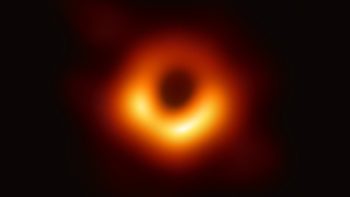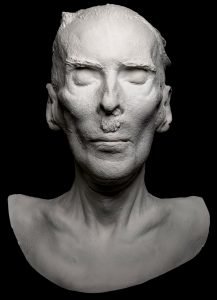An international team of scientists working with a global network of radio telescopes has produced the first-ever close-up image of a black hole.

The first ever image of a black hole.
Black holes also present us with a way to consider a perennial problem in psychoanalysis: ‘if you can’t see it how do you know it’s there?’
Few of Freud’s ideas are as unbelievable to the general public as his theory of the castration complex, yet his conviction about it grew as he got older. In his last book, unpublished in his lifetime, he says it “may probably be regarded as the central experience of the years of childhood.”
Yet “the whole occurrence…” Freud continues “… is so completely forgotten that its reconstruction during the work of analysis is met in adults by the most decided disbelief. Indeed, aversion to it is so great that people try to silence any mention of the proscribed subject and the most obvious reminders of it are overlooked by a strange intellectual blindness.”
What kind of ‘central experience’ can it be which is completely forgotten? Freud is routinely lambasted for positing bizarre invisible entities and offering untestable, magical explanations, so it may be valuable to introduce an analogy from a ‘hard(er)’ science.
How can one study an entity which is the psychical equivalent of a black hole?
Firstly we can study its effects in surrounding fields of experience. If the castration complex is as important as Freud claims it is, then its ‘gravitational pull’ should distort mental space and affect the distribution of mental objects.
The black hole in space may inhibit the movement of a nearby star, or speed it up; throw it off course or obscure its existence. Similarly, inhibitions or over-excitement, loss of mental balance or the absence of mental capacities, may be investigated as possible effects of the castration complex.
If the castration complex is as important as Freud claims it is, then its ‘gravitational pull’ should distort mental space and affect the distribution of mental objects.
The psychoanalyst Melanie Klein showed how inhibitions at school could be related directly to the ‘dread of castration’. What appeared to teachers as laziness or lack of interest, or awkwardness in games and athletics, revealed itself to Klein as a child buckling under the weight of castration fears. It was as if the child said: “If I do X, I will be punished (by castration)”. Only when the castration anxiety was resolved was it possible to make progress with the inhibition.
Similarly, a person’s special interests and sublimations may be a means of escape from the spectre of castration.
For Klein’s thirteen-year-old patient Felix, sex and football had become entwined in phantasy. “Coitus had already been replaced by football” Klein recounts, “and had absorbed his interest and ambition entirely.” The football was “a protection against other repressed and inhibited interests less consonant with the ego,” that is to say, those interests which bring with them the danger of attack.
Secondly we can investigate the black hole from first principles.
If you have a gravitational pull X, a critical mass Y, and atomic nuclei with the characteristics Z, then you will end up with an object so massive and compact that light cannot escape.
In similar fashion, a woman on the Channel 4 television programme A Man’s Best Friend (2002) hypothesised from first principles about castration. She remembered a male friend who compulsively touched his crotch whenever he spoke excitedly among his friends. “It must be strange having such a sensitive organ on the outside” she noted, “I’d be worried about it getting snapped off or bitten by a dog”.

Phallic amulet from Freud’s collection.
Any mother (or significant other) knows that the penis is of intense interest to the little boy who owns it. She may also be aware of her own complex feelings toward it. In ancient times phallic symbols and amulets were worn or touched to protect the owner from danger.
From first principles, then, we might say that such a psychically significant and precious object will inevitably bring with it the possibility of loss. Thus when the time is right, according to Freud, it takes very little to activate a sense of threat. There is, one might say, a preconception of castration in the mind; it seems to arise inevitably from within.
Unlike the castration complex, however, a black hole does not exist because the universe has an idea of a black hole.
In other words, the ‘castration complex’ is very much a matter of beliefs. It is our (unconscious) belief in castration that feeds the threat of castration.
One day, four year old Reuben told me of a curious implement he had heard about at his nursery. It was called a ‘willy-cut’. A willy-cut was like a pair of garden shears but with a much more restricted range of functions. His father was a gardener. After enquiring how he came to such a notion it transpired that he had based his sense of conviction on slender evidence; he had overheard one of the staff members at the nursery utter the enigmatic word – ‘Winnicott’!
Finally, the black hole can help us to understand the concept of ‘identification’.
Astronomers have found that a black hole lies at the centre of galaxies, including our own, the Milky Way. The structure of the galaxy, perhaps even its creation, is somehow connected to the presence of the black hole. Psychoanalysts have used the concept of ‘identification’ to describe the way in which psychic structure is developed.
Identification is not simply one psychical mechanism among others, but the operation itself whereby the human subject is constituted.
Identification is not just something we do once we’ve already become people in our own right; it is bound up in the process of becoming a person in the first place.
As the psychoanalysts Jean Laplanche and Jean-Bertrand Pontalis put it in their celebrated dictionary The Language of Psychoanalysis, identification is ‘not simply one psychical mechanism among others, but the operation itself whereby the human subject is constituted.’
In everyday parlance we often use the term to describe, say, how we relate to a character in a film; we ‘identify’ with the hero, perhaps. For Freud, identification is a quite complicated and, more to the point, energy-consuming process.
People don’t change easily, the ‘human subject’ is not constituted through a simple biological unfolding, and that’s what we are talking about in ‘identification’. Not to put too fine a point on it, Freud believes that in the process of growing up we only change when we have to. It is a massive economic upheaval and libidinal reorganisation, the aims and objects of the drives are transformed and replaced – think what that means in practice – and who would go through it without putting up a fight?
And we go through it more than once.
We talk about oral, anal and phallic stages of development but seldom about ‘identificatory stages’.
Yet we can see that how we relate to the world, the emotional valuations we give to objects and experiences, our interests and connections to the world, changes fundamentally with the accretion of new psychic structure in development.
At the core of the identificatory structure, as at the core of the galaxy, is a black hole around which the subject circulates and lives his life.
Growing up entails profound losses and disappointments, despite the promises it holds in our fantasies of being ‘big’. So what’s the thing that pushes us over the edge? What can it be that is strong enough to overcome the ‘organic inertia’, which Freud insists is a basic attribute of human subjectivity? Anxiety of course, the perception of a danger so severe and that seems so real that it scares us to death. Or rather, it would, if we were not able to eliminate the perceived danger by incorporating the alien thing into our own psychic structure – and change ourselves on that basis.
And this is where the analogy with the black hole comes in. At the core of our personalities at various stages of development, with our psychic structure formed through identification, lies a nugget of death.

Death mask of Sergei Pankejeff (the ‘Wolf Man’)
Not an abstract idea of death as something sui generis, but death as it is represented through the danger situations (as Freud describes them) of birth, separation, castration and loss of love. At the core of the identificatory structure, as at the core of the galaxy, is a black hole around which the subject circulates and lives his life. The activity of the subject is a reaction to this core, ever-present, invisible, and haunting the very house in which it lives.
Freud uses the term ‘desexualisation’ to describe the alteration of the aim and object of the drive which characterises identification. We can say then that reality exists only insofar as it is sexualised (as Lacan insists), or desexualised; or rather that reality exists as sexualised only insofar as a part of it is incorporated into the psychic apparatus as desexualised. As death.




Comments
“The core of the structure, the core of the galaxy” – this question of what is at the centre troubled Freud, in what Laplanche (using similarly astronomical language) describes as the conflict between his Copernicanism and his Ptolemaism; is the subject centred or decentred? Does the unconscious emerge from somewhere deep within, or is it implanted from without? Is man is supreme within his own mind, or not even master in his own house?
This black hole around which our lives swirl – this radically other thing (or no-thing) – is it death, or is it sex? Sex is implanted in me via the desires of the parent, who is both other and part of me – is that other just the child’s perception (the other being generated from within)? Or was the other really there, and if we ask enough questions, could we find him or her?
One can see how, from this conflict, psychoanalysis took such radically divergent paths: one school of thought wishing to promote the centredness of the subject by reacquainting her with the unconscious which, whilst buried deep within, still lies at the core of her being; another school claiming that the unconscious is inexorably other and impossible to assimilate or domesticate. What Lacan brings to this is the insight that the child receives messages from its parents about sexuality which are untranslatable, incomprehensible, not least because they include the parents’ own unconscious, but also because at this stage the child has not learned the shared code by which he might turn these cryptic messages into words and meanings.
I have probably muddied the waters here, but thank you for a stimulating article.
http://www.robertholmantherapy.com